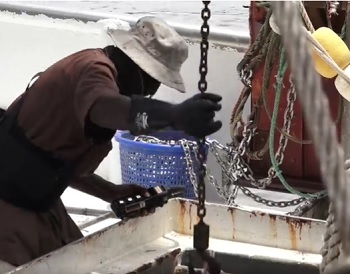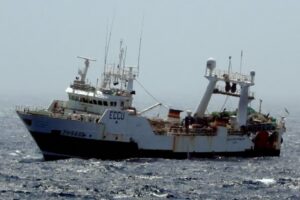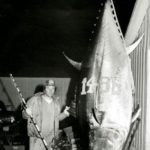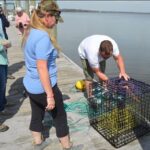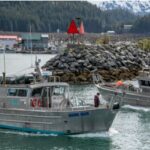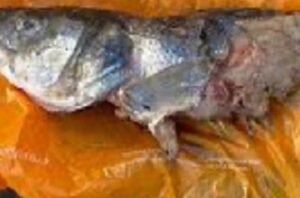Tag Archives: Dead Zone

Shrinking the Gulf Coast dead zone part 1: Downriver, part 2: Upriver
The Ace of Trade shrimp trawler motored toward Dean Blanchard’s dock early this summer and winched its nets into storage. Blanchard’s workers, strengthened by a lifetime at sea worked shirtless in the humid summer air. It was the beginning of hurricane season, and so far 2019 had been the wettest year in U.S. history. Blanchard has been in business for 37 years, and is one of the largest shrimp suppliers in America, distributing off the barrier island of Grand Isle in the Mississippi River Delta. >Click to read part one< >click to read part two< 11:00
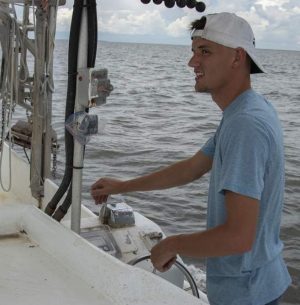
‘Dead zone’ worsens troubles for Louisiana shrimpers
Tommy Olander Jr. took his first baby steps on the deck of a 42-by-16-foot Lafitte skiff shrimp trawler. His dad, Thomas Olander, named the boat Tommy Boy after his son, now 25.
“I’d rather be broke and shrimping than get out of it,”,, But Olander did leave the business,,, The Louisiana shrimp industry is facing major economic and environmental challenges including low prices for shrimp, natural disasters, laws to protect endangered turtles and a Delaware-size dead zone with too little oxygen for aquatic life. “The main focus has been about prices,” said Acy Cooper, 58, president of the Louisiana Shrimp Association. “But there’s also (turtle excluder devices), the dead zone and freshwater diversion.” >click to read<10:09
Gulf of Mexico Now Largest Dead Zone in the World, and Factory Farming Is to Blame
 Nitrogen fertilizers and sewage sludge runoff from factory farms are responsible for creating an enormous dead zone in the Gulf of Mexico. As fertilizer runs off farms in agricultural states like Minnesota, Iowa, Illinois, Wisconsin, Missouri and others, it enters the Mississippi River, leading to an overabundance of nutrients, including nitrogen and phosphorus, in the water.,, This, in turn, leads to the development of algal blooms, which alter the food chain and deplete oxygen, resulting in dead zones. Needless to say, the fishing industry is taking a big hit, each year getting worse than the last. The featured news report includes underwater footage that shows you just how bad the water quality has gotten. Video, click here to read the story 14:13
Nitrogen fertilizers and sewage sludge runoff from factory farms are responsible for creating an enormous dead zone in the Gulf of Mexico. As fertilizer runs off farms in agricultural states like Minnesota, Iowa, Illinois, Wisconsin, Missouri and others, it enters the Mississippi River, leading to an overabundance of nutrients, including nitrogen and phosphorus, in the water.,, This, in turn, leads to the development of algal blooms, which alter the food chain and deplete oxygen, resulting in dead zones. Needless to say, the fishing industry is taking a big hit, each year getting worse than the last. The featured news report includes underwater footage that shows you just how bad the water quality has gotten. Video, click here to read the story 14:13
Gulf dead zone bigger than ever, affecting shrimping
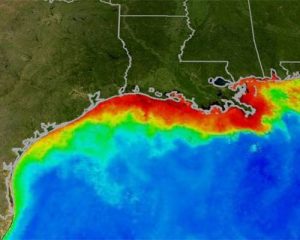 The Gulf of Mexico’s dead zone – an area starved of oxygen that cannot support life – has reached the largest size documented since mapping began 35 years ago, researchers maintain in a new report. The dimensions – this year the size of New Jersey – are of particular concern because they appear related to concerns expressed by shrimpers about their catch, particularly in Terrebonne Parish waters. “They may be catching some close to shore,” said Dr. Nancy Rabalais, the oceanographer who pioneered Gulf dead zone research and who compiled the most recent report on its effects. “But they are not going to get anything between Terrebonne Bay and 25 or 35 miles offshore.” That’s bad news, with the 2017 white shrimp season fast approaching. click here to read the story 14:49
The Gulf of Mexico’s dead zone – an area starved of oxygen that cannot support life – has reached the largest size documented since mapping began 35 years ago, researchers maintain in a new report. The dimensions – this year the size of New Jersey – are of particular concern because they appear related to concerns expressed by shrimpers about their catch, particularly in Terrebonne Parish waters. “They may be catching some close to shore,” said Dr. Nancy Rabalais, the oceanographer who pioneered Gulf dead zone research and who compiled the most recent report on its effects. “But they are not going to get anything between Terrebonne Bay and 25 or 35 miles offshore.” That’s bad news, with the 2017 white shrimp season fast approaching. click here to read the story 14:49
Price spikes for jumbo shrimp blamed on Gulf of Mexico dead zone
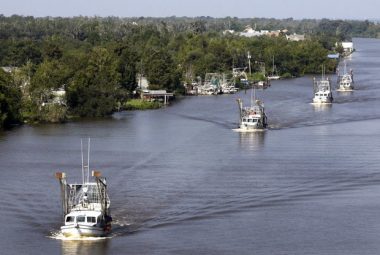 Every spring and summer when the low-oxygen dead zone forms off Louisiana’s coastline, the price of jumbo shrimp briefly spikes, affecting Gulf of Mexico fishers, consumers and seafood markets, according to a new study published Monday (Jan. 30) in the Proceedings of the National Academy of Sciences. And the price for smaller shrimp generally falls. The positive effect of the price increase on jumbo shrimp for Gulf commercial shrimpers are fleeting, however. That’s because the rise often triggers increased imports of large shrimp from foreign producers, including farm-raised shrimp, which quickly drive down prices. The dead zone is an area of low oxygen — with levels of oxygen at or below 2 parts per million — that scientists define as hypoxia. Freshwater rich in nitrogen and phosphorus from Midwest farms and from nutrient-rich sewage from cities and rural areas enters the Gulf each spring and summer, forming a freshwater layer over the Gulf’s saltier sea water. Read the full story here 18:41
Every spring and summer when the low-oxygen dead zone forms off Louisiana’s coastline, the price of jumbo shrimp briefly spikes, affecting Gulf of Mexico fishers, consumers and seafood markets, according to a new study published Monday (Jan. 30) in the Proceedings of the National Academy of Sciences. And the price for smaller shrimp generally falls. The positive effect of the price increase on jumbo shrimp for Gulf commercial shrimpers are fleeting, however. That’s because the rise often triggers increased imports of large shrimp from foreign producers, including farm-raised shrimp, which quickly drive down prices. The dead zone is an area of low oxygen — with levels of oxygen at or below 2 parts per million — that scientists define as hypoxia. Freshwater rich in nitrogen and phosphorus from Midwest farms and from nutrient-rich sewage from cities and rural areas enters the Gulf each spring and summer, forming a freshwater layer over the Gulf’s saltier sea water. Read the full story here 18:41
This year’s dead zone in the Gulf of Mexico covers an area the size of Connecticut
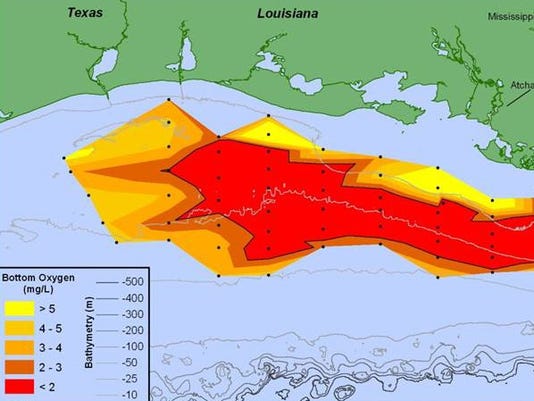
The dead zone covers a large area of the Gulf but is not as large as scientists originally predicted, according to Nancy Rabalais, executive director of LUMCON, the Louisiana Universities Marine Consortium, and head of the dead zone research cruise. continued@houmatoday
New Virginia Institute of Marine Science study shows ‘dead zone’ impacts Chesapeake Bay fishes
The study, published in the May issue of Marine Ecology Progress Series, was authored by Andre Buchheister, a Ph.D. student in William & Mary’s School of Marine Science at VIMS, along with VIMS colleagues Chris Bonzek, Jim Gartlan d, and Dr. Rob Latour. Low-oxygen conditions—what scientists call “hypoxia”—form when excessive loads of nitrogen from fertilizers, sewage, and other sources feed algal blooms in coastal waters. [email protected]
d, and Dr. Rob Latour. Low-oxygen conditions—what scientists call “hypoxia”—form when excessive loads of nitrogen from fertilizers, sewage, and other sources feed algal blooms in coastal waters. [email protected]
How big will the Gulf Dead Zone get this year?
 LiveScience -The predicted size of this year’s Gulf of Mexico Dead Zone depends on whom you ask. One forecast model predicts an unusually small area of oxygen-depleted water, while another predicts an extent in line with the recent average. continued
LiveScience -The predicted size of this year’s Gulf of Mexico Dead Zone depends on whom you ask. One forecast model predicts an unusually small area of oxygen-depleted water, while another predicts an extent in line with the recent average. continued






